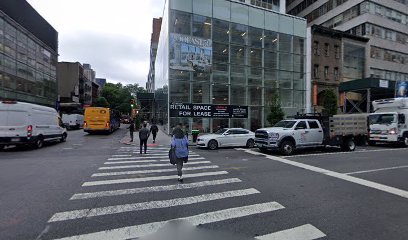
Not another High Line hotel: CB4 District Manager Bob Benfatto says Jamestown Properties has no plans to build atop its Milk Studios space — but as is, they’ve got the right to (if they get more FAR rights).
BY SCOTT STIFFLER | Construction to vertically expand Chelsea Market won’t begin until 2015 — but a provision secured during the lengthy review process that ultimately allowed Jamestown Properties to upzone its iconic structure is already being discussed by Community Board 4 (CB4).
In an October 25, 2012 press release announcing the approval of Jamestown’s Uniform Land Use Review Procedure (ULURP) application, City Council Speaker Christine Quinn invoked a West Chelsea Rezoning Study as one of the “key victories raised by the local community and the Borough President.”
The Department of City Planning (DCP) and CB4, Quinn noted, have until June 30, 2013 to “engage in a collaborative planning process” and submit draft recommendations to the City Council that would “assess the future of the expansion of the Special West Chelsea District.”
The dimensions of the Rezoning Study, the council’s press release specified, “will be the area bounded by 11th and 12th Avenues and will also include 85 and 99 10th Avenue, the South side of West 15th Street and the east side of 10th Avenue between 14th and 15th Street.”
CRACKS IN THE FACADE?
The Special West Chelsea District (SWCD) was created in 2005 to allow new development, largely residential, in an area zoned for light manufacturing and commercial use (mostly from 14th to 30th Streets on Ninth and Tenth Avenues, the “Northern Triangle” from 25th to 30th Streets between 11th and 12th Avenues, and also along some midblocks).
At the time, CB4 strongly advocated for Chelsea Market (and the 15th Street area, across from the market) to be included — but its failure to do so set the stage for 2012’s contentious ULURP process, during which the SWCD’s area of coverage was a bone of contention during a series of public hearings at the CB4, Borough President and City Planning Commission levels.
In a January 22 phone interview, CB4 District Manager Bob Benfatto asserted that had Chelsea Market been subject to SWCD requirements, “then you would not have seen a building with as many setbacks, and as tall, as you do in the Chelsea Market [design] now. They would have never approved it.”
SLIDESHOW MAPS PRELIMINARY CHAGES
CB4’s Chelsea Land Use Committee (CLU) met on January 14, to share with the public their initial thoughts on SWCD expansion. Co-Chair J. Lee Compton and committee member Betty Mackintosh took the nearly two dozen attendees through a generally well-received slideshow offering initial zoning recommendations based on possible height, bulk, Floor Area Ratio (FAR) and commercial/residential use scenarios, and speculative remedies for challenges specific to the Northern and Southern Study Area.
Among the recommendations (in a slide titled “Study Goals for SWCD Expansion), CLU cited the need to “encourage and guide development as a mixed use neighborhood” as well as “ensure that the use and form of new buildings relates to and enhances the neighborhood.” Adding the proposed areas to the SWCD would, Benfatto told Chelsea Now, eliminate the current problem of donut holes (described by Compton as “a different zone within a zone”).
As is, blocks with multiple zoning areas are subject to construction projects with much greater height than their immediate neighbors. “Re-regulating the zoning,” said Benfatto, “changes the allowable envelope of development. You would, in essence, be cutting out or filling in the donut holes.”
LAND USE COMMITTEE UNVEILS PRELIMINARY PLANS
Posing the rhetorical question, “Why not leave well enough alone?,” Compton noted that in its current state, the SWCD “is a subset of what we wanted all along.” He recalled that when “City Planning gave us the area we now know as the Special West Chelsea District” back in 2005, “we immediately started talking about expansion. Every year, we include it in the Statement of District Needs.”
Now that the City Council has compelled DCP to either recommend changes or forego the notion altogether, CB4 has seized the opportunity to formulate its own detailed plan.
“With our preliminary study,” said Compton, “we’re hoping they’ll say, ‘You’ve done a lot of legwork’ ” and adopt CB4’s suggestions wholesale (or at least use them as an effective template).
“We’re in a very different position from 2004,” said Compton. “We’ve learned from Sandy and Chelsea Market.”
GOOD STREET WALLS MAKE GOOD NEIGHBORS?
Ground level aesthetics and community benefits were also on the CLU’s radar, with Mackintosh walking the audience through a slide titled “If SWCD is Not Expanded” — and noting that currently, the area under consideration is subject to new buildings whose commercial nature would be out of synch with the surrounding area. “We could exclude hotel use,” she suggested, “and require street walls, set height limits and [establish] an Affordable Housing requirement.”
Compton also spoke of the need for street walls (which, if consistent throughout the block, would create an even level to the building facades). Referencing a number of recent construction projects in the area, he observed, “A favorite trick we’ve seen is, they’ll set back from the sidewalk. It allows them to go high, slender, whereas in much of Chelsea, buildings are built on the lot line, which maintains the context and feeling of the area.”
CB4 member Joe Restuccia cited another consequence of unfettered access to hotel construction, warning that the area could become “another entertainment district that people are traveling across a residential district to get to” full of hotels and clubs whose cumulative effect might cause the area to resemble a “wild Meatpacking District.”
Compton spoke about the property at 450 West 15th Street (close to the High Line). The eight-story building, known locally as the Milk Studios space was, he noted, recently purchased by Jamestown Properties. “We have no idea what’s happening” there, he said, but wondered if the property may be destined to fulfill ambitions scrapped during the Chelsea Market ULURP process.
“Since Jamestown did not get their hotel,” Compton speculated on January 14, “it’s reasonable to think they might want to put a hotel on this site.”
But by the time Chelsea Now spoke with Benfatto on January 22, he had been told by Jamestown that “they have no plans to build a hotel. My understanding is they plan to put a loading dock on the 15th Street side and open up the 14th Street side to retail.” Echoing CLU concerns, though, Benfatto noted that without SWCD protection, the Milk Studios building and a large vacant lot space on the same block “could all become hotels, and build up, if they want to.” Vertical expansion that exceeds a property’s existing air rights could take place if the owner accumulates the necessary FAR space, purchased from nearby land.
Benfatto said that “If they [Jamestown] were to merge with the empty lot where the car wash used to be or buy off the air rights, which I believe is another four FAR, they could put it on top” of the Milk Studios building and “increase to a height of 15 stories.”
ZONE A CONCERNS
During the Q&A session, a member of the public challenged the very notion of additional construction on the West side of Chelsea. “Why,” he asked “are we contemplating building these densities in Zone A? This puts lives at risk.”
Mackintosh conceded the point, saying that “The issue of building in a flood zone is an interesting one that started me thinking about more innovative treatment of the properties; maybe adding soft edges and requiring other features.” Compton referenced his hope for new construction projects “getting infrastructure up on top of the buildings,” and Benfatto told Chelsea Now that flooding, although important, is a “peripheral issue” to current SWCD considerations. It is, however, “an issue the board will be pursuing on its own. The Waterfront, Parks and Environment Committee has already started preliminary discussions on this.”
CLU TO PROVIDE UPDATE ON FEB. 19
Compton said the CLU will meet soon with the DCP and report back to the public on February 19 (consult nyc.gov/mcb4 closer to the date, for the exact location). On the night of January 14, however, the committee declined repeated requests to put its comprehensive slideshow online — noting that much of its content would be rendered moot by evening’s end, based on audience feedback and committee discussion. After February 19, Compton promised, information will be available on the CB4 website, reflecting the CLU’s most evolved position.

















